'BSG' Flashback: The Time Jump that Changed Television
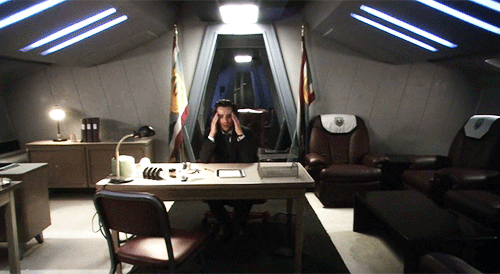
During their four-year mission to locate the mythical planet Earth, the crew of the increasingly decrepit Battlestar Galactica stayed ahead of their relentless Cylon pursuers by jumping. Not literally, of course. Among the starship’s defense mechanisms was a “Faster Than Light” Drive that allowed the massive Battlestar, as well as the smaller ships in the ragtag fleet, to essentially teleport — or “jump” — from part of the galaxy to another. It’s a tactic that Galactica’s indomitable commander, William Adama (Edward James Olmos), relied on many times to either avoid or initiate a battle with the race of replicant cyborgs that had decimated mankind.
But the show’s most significant jump didn’t involve Galactica’s FTL Drive. Ten years ago tonight — Mar. 10, 2006 — Syfy (or, as it was still known then, Sci-Fi) premiered “Lay Down Your Burdens, Part 2,” the second installment of an eventful two-part Season 2 finale that shook up Battlestar Galactica’s always-fragile status quo. By that time in the show’s run, fans had learned to expect the unexpected from showrunner Ronald D. Moore, who employed socially-conscious storylines and thrilling twists to revitalize a ‘70s TV franchise that was mostly remembered as a campy Star Wars rip-off.
In “Burdens, Part 2,” Moore unveiled one of his boldest narrative gambits: a “one year later” time jump that happens within the span of a 90-second shot that pushes in and then pulls back from the face of newly-installed president, Gaius Baltar (James Callis). The artfulness of the scene only increased the surprise factor, and the reaction amongst viewers at the time can only be described as shock and awe. And Moore recognized the gamble he was taking. “We are placing a large bet on this,” he remarks on the DVD commentary track. “The audience at this point is going, ‘It’s a dream; they don’t mean it!’ No we mean it. It’s really a year later.” Speaking with Yahoo TV, the episode’s director, Michael Rymer, confirmed that the time jump was always part of the script. “The intention was to take this extreme leap right at the end of the season,” he says. “And part of the twist is that you don’t expect it to happen.”
Let’s do our own jump backwards in time in order to lay the groundwork for the episode’s leap forward. The first chapter of “Burdens” opens with the discovery of a planet that’s capable of sustaining human life. Even though this world isn’t the promised land of Earth, to the demoralized fleet it represents a chance to plant their feet on terra firma for the first time since fleeing their now-destroyed home planet, Caprica. Squirrelly scientist-turned-presidential candidate Baltar (James Callis) seizes upon the discovery, making the founding of “New Caprica” a central tenant in his campaign to unseat the beleagured current executive, Laura Roslin (Mary McDonnell). “Burdens, Part 2” picks up on Election Day, when a fiercely divided electorate appears to hand Roslin the victory, until it’s revealed that her win was rigged. Baltar inherits the presidential chair, but his first day on the job is marred by tragedy when a Cylon prisoner — one he’s been intimate with — detonates a nuclear bomb, destroying several of the fleet’s ships.
In a tense meeting with Adama, Baltar makes it clear he’s not going to let the tragedy avert his campaign promise to populate New Caprica. Left alone in his office, he sits at his desk and feels the weight of his new position, allowing his head to sink into his hands. The camera starts out at a distance and then slowly, pushes forward until it reaches his bowed head.
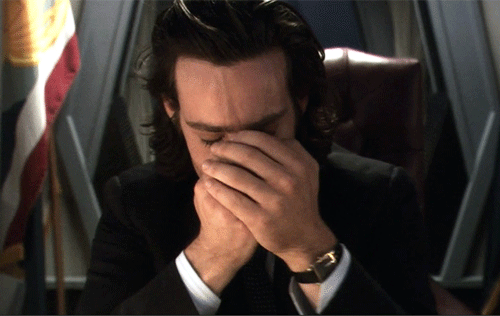
After a beat, it moves backward again, revealing a substantially altered Baltar — whose brown hair now has a greyish tint–in substantially altered surroundings.
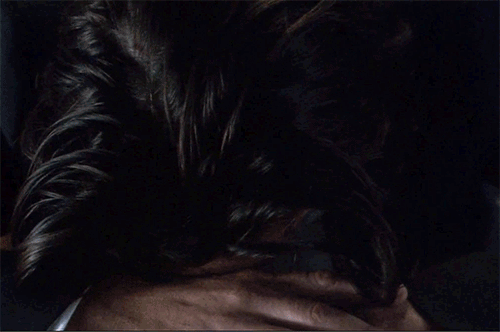
Clearly hung over, he whines about the citizens’ many complaints (“We survived a nuclear holocaust, and the people complain about the weather,” he snaps at his Chief of Staff), while a scantily clad female companion can be seen getting dressed in the background.
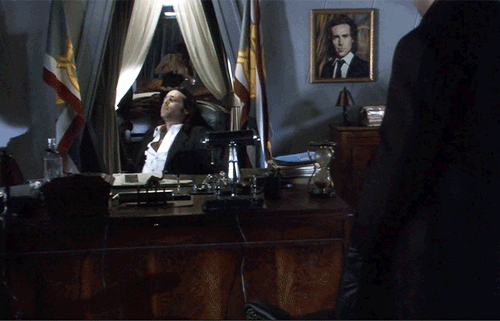
A “One Year Later” timestamp confirms that much time has passed — and much has gone wrong — since New Caprica became a reality. In a mere minute-and-a-half, the episode has covered twelve months’ worth of narrative, and sets the stage for even worse events (like a Cylon invasion) to come.
Let’s be clear: BSG didn’t invent the idea of a series taking a giant leap forward in its chronology. In 2003, for example, the series finale of Dawson’s Creek flipped the calendar ahead five years, while Alias closed out its second season with the revelation that Sydney Bristow had lost 24 months of her life. Jumping even further back to 1990, the final season of the Vietnam War drama China Beach fast-forwarded to 1985, and used flashbacks to fill in the sizable time gap. In those series, though, the time jump was either revealed upfront or, in the case of Alias, saved for the closing moments of the episode.
In “Burdens, Part 2,” which originally aired as a 90-minute special, the jump happens at the 45-minute mark and the episode continues for another half-hour. On the DVD commentary track, Moore’s producing partner, David Eick, reveals that they originally contemplated going a more conventional route by saving the “One Year Later” reveal for Season 3 premiere, but then they hit upon the notion of jumping forward in the middle of the finale, and decided to throw convention to the wind. “We really became enamored of the boldness of it,” Moore says. “Move it a year forward and just keeping going.”
As Moore remembers on the commentary track, his original plan had the jump occurring in the space of a single cut. One moment, Baltar would be standing in front of a window, and when he turns around to talk to his Chief of Staff, they’re one year in the future. Rymer says that his director’s cut of the episode treated the time jump in a similarly jarring fashion. “I tried a jump cut right from Baltar in his office to the surface of New Caprica. That was also quite interesting. It was like ‘What the f–k, where is this?’” The episode’s editor, Jacque Gravett, recalls watching that version in the editing room, before Rymer, Moore and Eick settled on the more gradual push-in, pull-back transition. “They both worked equally well, but I think this one is a little more graceful. It’s more cinematic, as opposed to the straight cut [to New Caprica].”
Although the time jump appears as a seamless shot in the finished episode, Rymer says that the two camera moves, which were executed with the use of a dolly track, were filmed on separate days. “We planned it so that the first part of the shot was filmed at the end of the first day, and then scheduled the next piece for later, because it took some time to set up Baltar’s world [after the time jump] and decide how sleazy we could make it.” The visual symmetry of the sequence is reinforced by the fact that the push-in and pull-back last roughly 45 seconds each. That’s an eternity for a series that otherwise employed a rapid-fire editing style that rarely lingered on any one shot. And Gravett says that his first pass at the time jump sequence in the editing room might have been even longer. “I really loved to stay with shots whenever possible, so I can almost say with certainty that what’s in there is probably a trimmed-down version. And that camera move is similar to what a lot of directors are doing now. On the series I just worked on, ABC’s The Family, most of the transitions were done in camera, and they’re very similar to what Michael was doing 10 years ago.”
The influence of BSG’s bold time jump is certainly evident in the past decade of television storytelling. Since 2006, numerous shows have deliberately moved their chronology clock forward to open up new storytelling possibilities — a list that includes such disparate series as Desperate Housewives, Fringe, One Tree Hill and Vikings. And a few of these time jumps either overtly or subtly reference “Burdens.” Parks and Recreation co-creator Mike Schur publicly credited BSG as the inspiration for the “Three Years Later” leap his series took in the Season 6 finale, right down to the seamless push-in, pull-back shot.
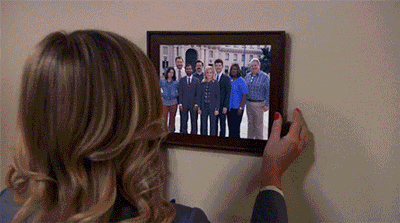
Meanwhile, the eighth episode of Fargo’s first season elides a year in the characters’ lives with a graceful tracking shot. (Creator Noah Hawley didn’t specifically reference BSG in interviews, but the two sequences do feel like a distant relatives.)
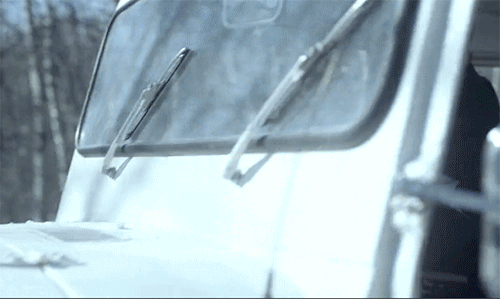
Neither Rymer nor Gravett insist that BSG deserves credit for popularizing the time jump on contemporary television, but both express pride at having been part of a series that’s still talked about in glowing terms. “When I go into a meeting for a show, nine times out of ten one of the things we talk about is Battlestar,” Gravett says. And Rymer, whose post-Galactica résumé includes episodes of American Horror Story, Hannibal and Jessica Jones, has a special fondness for “Lay Down Your Burdens, Part 2” for reasons other than the time jump. “That episode is one of my personal favorites. I watched it recently and thought, ‘God, this really does work.’ I think we were peaking then — it was all coming together. There are a lot of times where I’m watching something [new] and I go, ‘Hang on, we did that!’ It’s always flattering.”
What’s your favorite TV time-jump ever? Take our poll!
All four seasons of Battlestar Galactica can currently be streamed on Hulu

